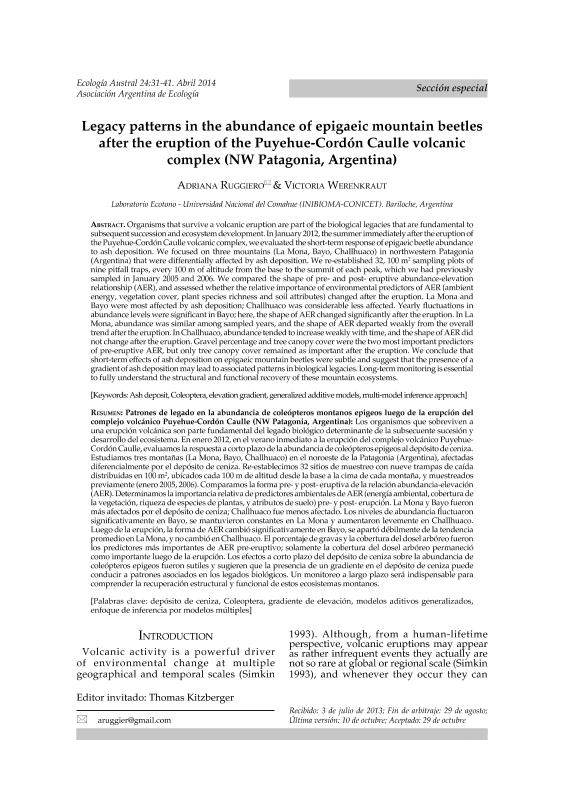Mostrar el registro sencillo del ítem
dc.contributor.author
Ruggiero, Adriana

dc.contributor.author
Werenkraut, Victoria

dc.date.available
2017-10-13T22:30:37Z
dc.date.issued
2014-09-29
dc.identifier.citation
Ruggiero, Adriana; Werenkraut, Victoria; Legacy patterns in the abundance of epigaeic mountain beetles after the eruption of the Puyehue-Cordon Caulle volcanic complex (NW Patagonia, Argentina); Asociación Argentina de Ecología; Ecología Austral; 24; 1; 29-9-2014; 31-41
dc.identifier.issn
0327-5477
dc.identifier.uri
http://hdl.handle.net/11336/26675
dc.description.abstract
Organisms that survive a volcanic eruption are part of the biological legacies that are fundamental to subsequent succession and ecosystem development. In January 2012, the summer immediately after the eruption of the Puyehue-Cordón Caulle volcanic complex, we evaluated the short-term response of epigaeic beetle abundance to ash deposition. We focused on three mountains (La Mona, Bayo, Challhuaco) in northwestern Patagonia (Argentina) that were differentially affected by ash deposition. We re-established 32, 100 m2 sampling plots of nine pitfall traps, every 100 m of altitude from the base to the summit of each peak, which we had previously sampled in January 2005 and 2006. We compared the shape of pre- and post- eruptive abundance-elevation relationship (AER), and assessed whether the relative importance of environmental predictors of AER (ambient energy, vegetation cover, plant species richness and soil attributes) changed after the eruption. La Mona and Bayo were most affected by ash deposition; Challhuaco was considerable less affected. Yearly fluctuations in abundance levels were significant in Bayo; here, the shape of AER changed significantly after the eruption. In La Mona, abundance was similar among sampled years, and the shape of AER departed weakly from the overall trend after the eruption. In Challhuaco, abundance tended to increase weakly with time, and the shape of AER did not change after the eruption. Gravel percentage and tree canopy cover were the two most important predictors of pre-eruptive AER, but only tree canopy cover remained as important after the eruption. We conclude that short-term effects of ash deposition on epigaeic mountain beetles were subtle and suggest that the presence of a gradient of ash deposition may lead to associated patterns in biological legacies. Long-term monitoring is essential to fully understand the structural and functional recovery of these mountain ecosystems.
dc.description.abstract
Los organismos que sobreviven a una erupción volcánica son parte fundamental del legado biológico determinante de la subsecuente sucesión y desarrollo del ecosistema. En enero 2012, en el verano inmediato a la erupción del complejo volcánico PuyehueCordón Caulle, evaluamos la respuesta a corto plazo de la abundancia de coleópteros epigeos al depósito de ceniza. Estudiamos tres montañas (La Mona, Bayo, Challhuaco) en el noroeste de la Patagonia (Argentina), afectadas diferencialmente por el depósito de ceniza. Re-establecimos 32 sitios de muestreo con nueve trampas de caída distribuidas en 100 m2 , ubicados cada 100 m de altitud desde la base a la cima de cada montaña, y muestreados previamente (enero 2005, 2006). Comparamos la forma pre- y post- eruptiva de la relación abundancia-elevación (AER). Determinamos la importancia relativa de predictores ambientales de AER (energía ambiental, cobertura de la vegetación, riqueza de especies de plantas, y atributos de suelo) pre- y post- erupción. La Mona y Bayo fueron más afectados por el depósito de ceniza; Challhuaco fue menos afectado. Los niveles de abundancia fluctuaron significativamente en Bayo, se mantuvieron constantes en La Mona y aumentaron levemente en Challhuaco. Luego de la erupción, la forma de AER cambió significativamente en Bayo, se apartó débilmente de la tendencia promedio en La Mona, y no cambió en Challhuaco. El porcentaje de gravas y la cobertura del dosel arbóreo fueron los predictores más importantes de AER pre-eruptivo; solamente la cobertura del dosel arbóreo permaneció como importante luego de la erupción. Los efectos a corto plazo del depósito de ceniza sobre la abundancia de coleópteros epigeos fueron sutiles y sugieren que la presencia de un gradiente en el depósito de ceniza puede conducir a patrones asociados en los legados biológicos. Un monitoreo a largo plazo será indispensable para comprender la recuperación estructural y funcional de estos ecosistemas montanos.
dc.format
application/pdf
dc.language.iso
eng
dc.publisher
Asociación Argentina de Ecología

dc.rights
info:eu-repo/semantics/openAccess
dc.rights.uri
https://creativecommons.org/licenses/by-nc-sa/2.5/ar/
dc.subject
Ash Deposit
dc.subject
Coleoptera
dc.subject
Elevation Gradient
dc.subject
Generalized Additive Models
dc.subject.classification
Bioquímica y Biología Molecular

dc.subject.classification
Ciencias Biológicas

dc.subject.classification
CIENCIAS NATURALES Y EXACTAS

dc.title
Legacy patterns in the abundance of epigaeic mountain beetles after the eruption of the Puyehue-Cordon Caulle volcanic complex (NW Patagonia, Argentina)
dc.title
Patrones de legado en la abundancia de coleópteros montanos epigeos luego de la erupción del complejo volcánico Puyehue-Cordón Caulle (NW Patagonia, Argentina)
dc.type
info:eu-repo/semantics/article
dc.type
info:ar-repo/semantics/artículo
dc.type
info:eu-repo/semantics/publishedVersion
dc.date.updated
2017-08-09T14:05:27Z
dc.identifier.eissn
1667-782X
dc.journal.volume
24
dc.journal.number
1
dc.journal.pagination
31-41
dc.journal.pais
Argentina

dc.journal.ciudad
Córdoba
dc.description.fil
Fil: Ruggiero, Adriana. Consejo Nacional de Investigaciones Científicas y Técnicas. Centro Científico Tecnológico Conicet - Patagonia Norte. Instituto de Investigaciones En Biodiversidad y Medioambiente. Universidad Nacional del Comahue. Centro Reg.universidad Bariloche. Instituto de Investigaciones En Biodiversidad y Medioambiente; Argentina
dc.description.fil
Fil: Werenkraut, Victoria. Consejo Nacional de Investigaciones Científicas y Técnicas. Centro Científico Tecnológico Conicet - Patagonia Norte. Instituto de Investigaciones En Biodiversidad y Medioambiente. Universidad Nacional del Comahue. Centro Reg.universidad Bariloche. Instituto de Investigaciones En Biodiversidad y Medioambiente; Argentina
dc.journal.title
Ecología Austral

dc.relation.alternativeid
info:eu-repo/semantics/altIdentifier/url/http://ojs.ecologiaaustral.com.ar/index.php/Ecologia_Austral/article/view/35
dc.relation.alternativeid
info:eu-repo/semantics/altIdentifier/url/http://ref.scielo.org/j9nw6j
Archivos asociados
